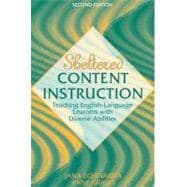
All chapters conclude with “Summary,” “Activities,” and “References.”
Preface.
1. Teaching English-Language Learners with Diverse Abilities.
Native Language Knowledge.
English Language Knowledge.
Academic Background and School Experience.
Learning and Behavior Patterns.
2. Theoretical and Historical Foundations.
History of Education for Students Learning English in School.
Learning Theories.
Theories of Second Language Acquisition.
The Contributions of Cummins.
Factors That Affect Second Language Acquisition.
3. Sheltered Instruction in the Content Areas.
Sheltered Instruction versus Effective Instruction.
A Comparative Case Study.
Components of Sheltered Instruction.
Overlap of Sheltered Instruction and Effective Instruction.
Specific Considerations for Students with Learning Disabilities.
4. Affective Issues.
Providing Constructivist Reading and Writing Activities.
Providing Ample Practice and Careful Corrections.
Focusing on Relevant Background Knowledge.
Actively Involving Learners.
Using Alternative Grouping.
Providing Native Language Support.
Focusing on Content and on Activities That Are Meaningful to Students.
Creating Roles in the Classroom for Family and Community Members.
Holding High Expectations for All Learners.
Being Responsive to Cultural and Personal Diversity.
5. Learning Strategies.
Types of Learning Strategies.
Guidelines for Selecting a Learning Strategy.
Lesson Phases When Teaching Learning Strategies.
Presentation Methods Used to Teach Learning Strategies.
Examples of Specific Strategies in Teaching Reading and Writing in Content Areas.
6. Curriculum Adaptations.
Demonstrating Sensitivity to Cultural and Linguistic Diversity.
Providing Adequate Background Knowledge.
Categorizing Materials as Either Content Knowledge or Academic Proficiency.
Including Both Language Development and Content Vocabulary Development.
Modifying the Text.
Modifying the Assignments.
Assigning Note Taking, Report Writing, Study Sheets and Homework, and Progress Checks.
Using Study Resource Guides.
Developing Methods to Facilitate Curriculum Adaptations.
7. Adjusting Discourse to Enhance Learning.
The Discourse of Sheltered Instruction.
The Discourse of Instructional Conversations.
Theoretical Background.
8. Self Evaluation and Collaborative Implementation.
Self Evaluation and Goal Setting.
Collaboration with School Personnel or Peers.
Index.
The New copy of this book will include any supplemental materials advertised. Please check the title of the book to determine if it should include any access cards, study guides, lab manuals, CDs, etc.
The Used, Rental and eBook copies of this book are not guaranteed to include any supplemental materials. Typically, only the book itself is included. This is true even if the title states it includes any access cards, study guides, lab manuals, CDs, etc.